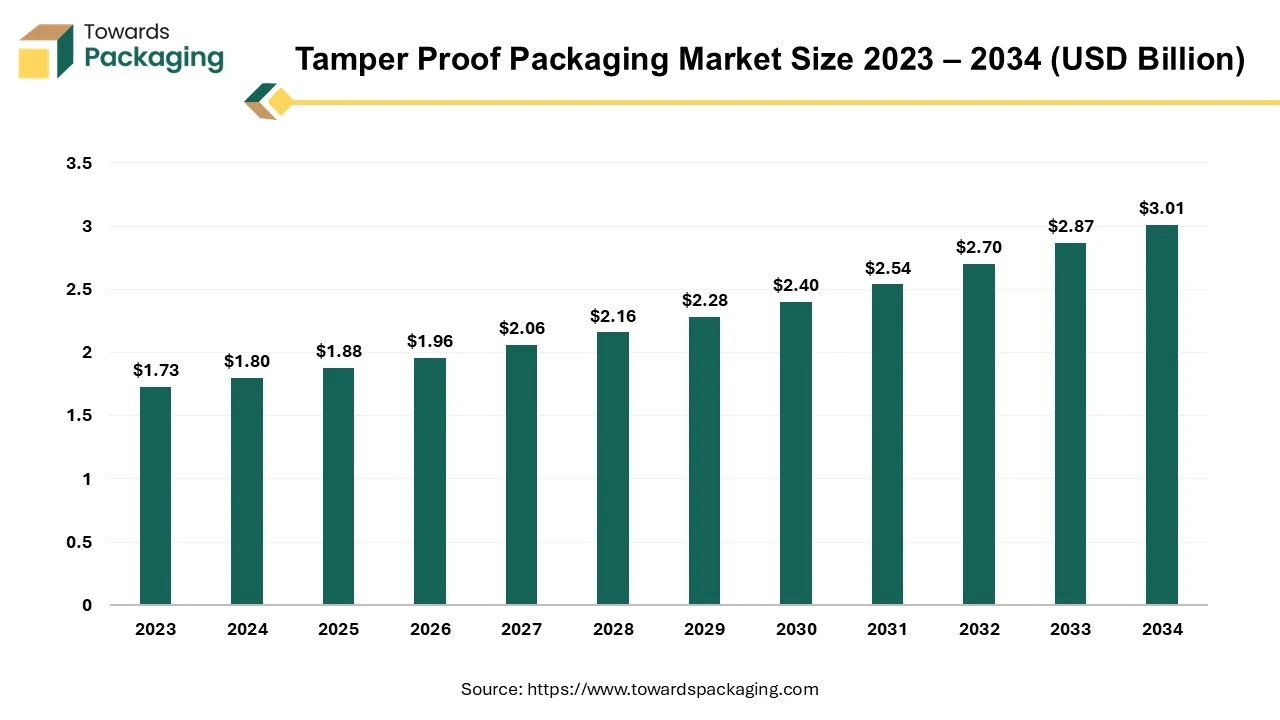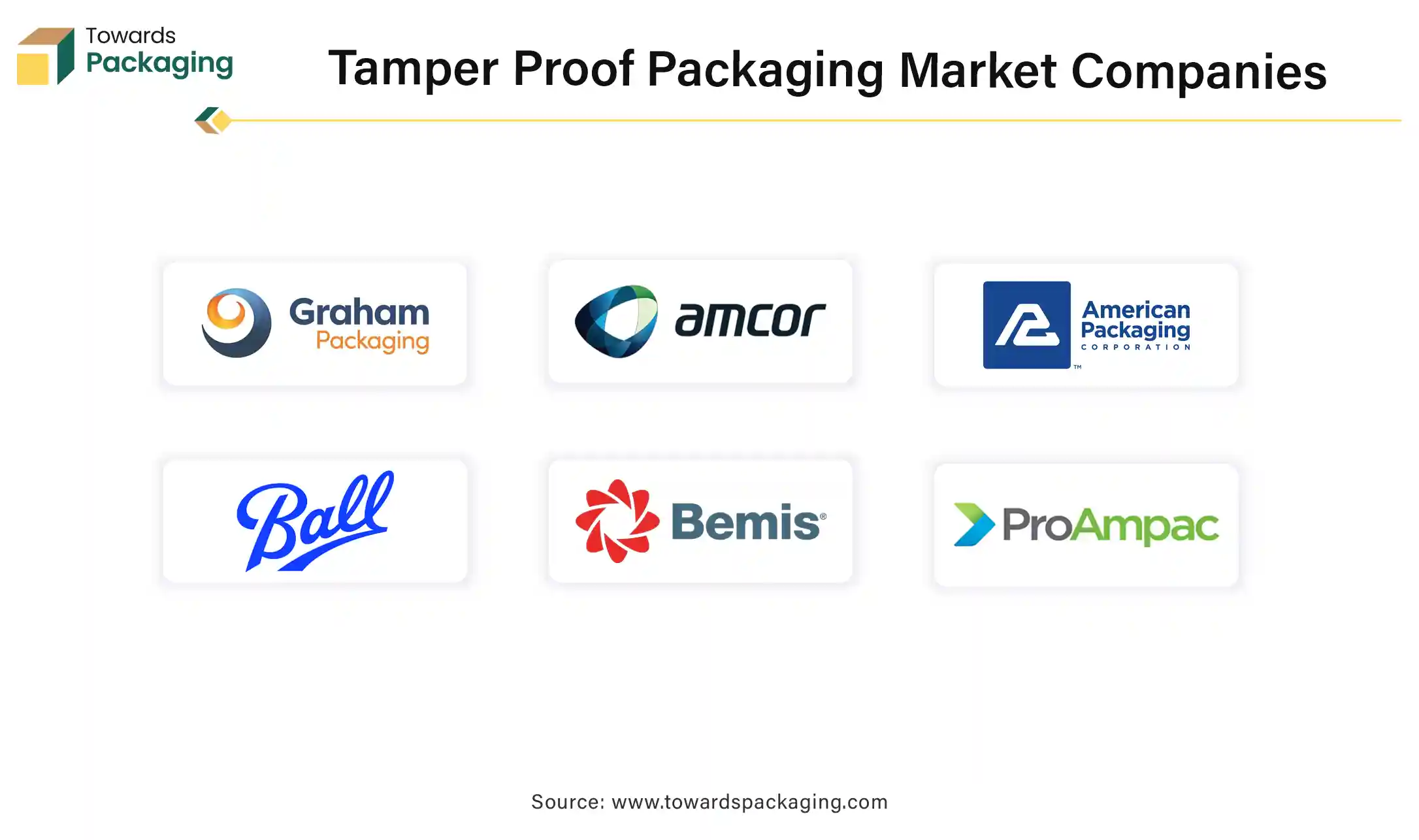April 2025
The global tamper-proof packaging market was valued at $36.6 billion in 2024 and is set for significant growth, projected to reach $70.99 billion by 2034. This expansion is driven by a compound annual growth rate (CAGR) of 6.85% from 2025 to 2034.

Unlock Infinite Advantages: Subscribe to Annual Membership
Tamper-proof packaging is known as packaging engineered to protect the contents of a product from unauthorized access, alteration, or contamination before it is opened by the consumer. It often includes features or mechanisms that make it obvious if the package has been opened, damaged, or otherwise tampered with.
Seals or wrappers must be broken or removed to access the product, such as shrink wraps or foil seals. Tamper-proof packaging is widely utilized in industries such as food, pharmaceuticals, cosmetics, and consumer goods to ensure safety, maintain trust, and comply with regulations.
The integration of advanced technologies such as Near-Field Communication (NFC), Radio Frequency Identification (RFID), and blockchain into packaging solutions is enhancing product security and supply chain transparency. These innovations facilitate real-time tracking and authentication, bolstering consumer confidence.
Stringent regulations imposed by authorities like the U.S. Food and Drug Administration (FDA) mandate the use of tamper-evident packaging, especially in the pharmaceutical sector. Additionally, increasing consumer awareness regarding product safety and authenticity is propelling the demand for secure packaging solutions.
There is a growing emphasis on developing eco-friendly and sustainable tamper-proof packaging materials. Manufacturers are adopting recyclable and biodegradable materials to meet environmental standards and cater to environmentally conscious consumers.
Major retailers are transitioning from traditional barcodes to QR codes on product packaging. This shift enhances product security by enabling consumers to access detailed product information and verify authenticity through simple smartphone scans. For instance, UK supermarkets like Tesco, Ocado, and Morrisons have begun implementing QR codes on items such as milk cartons.
The incorporation of Internet of Things (IoT) technologies into packaging is on the rise. Features like Near Field Communication (NFC) tags and Radio Frequency Identification (RFID) chips give permission for real-time tracking and authentication, enhancing supply chain transparency and product security.
Consumers are gravitating towards packaging designs that are both functional and aesthetically pleasing. Minimalist and transparent packaging not only showcases the product but also reduces waste, aligning with environmental concerns.
Increased focus on packaging that serves multiple purposes or can be reused, contributing to sustainability efforts. For example, some packaging designs are intended to be repurposed as storage solutions, adding value for consumers and minimizing environmental impact.
AI integration can significantly improve the growth of the tamper-proof packaging industry by enhancing operational efficiency, security, and customer trust. AI-powered image recognition and sensors can detect tampering by analyzing packaging seals, labels, or surface integrity in real-time. This technology can be applied during manufacturing, transportation, or at point-of-sale to identify breaches quickly.
AI-driven supply chain monitoring systems can track products at every stage of the distribution process. Combining AI with technologies like blockchain ensures a transparent, tamper-proof record of product movement and handling. AI can predict potential faults in packaging machinery, reducing the risk of improperly sealed or damaged products entering the market. This ensures consistent quality and minimizes waste caused by faulty packaging.
AI-integrated QR codes or NFC tags on tamper-proof packaging can enable consumers to verify a product's authenticity using smartphone apps. AI can analyze user interactions with these tags to detect fraudulent attempts or unusual activity. AI can analyze patterns and anomalies in packaging materials, labels, or holograms to identify counterfeit products, especially in high-risk industries like pharmaceuticals or luxury goods.
The rapid growth of online shopping has heightened concerns about product integrity during shipping, prompting companies to adopt tamper-evident packaging to maintain consumer trust. E-commerce involves multiple touchpoints during shipping, such as warehouses, delivery hubs, and transportation, increasing the risk of tampering. Tamper-proof packaging ensures product integrity throughout the supply chain.
Online shoppers often cannot inspect products physically before purchasing. Tamper-proof packaging builds trust by guaranteeing that the items arrive in their original, unopened condition. High-value goods like electronics, luxury items, and pharmaceuticals sold online require secure packaging to protect against theft or tampering, driving demand for advanced tamper-evident solutions.
Major e-commerce platforms, such as Amazon, require sellers to use secure packaging to protect products during transit. These requirements promote the adoption of tamper-proof packaging among vendors. Consumers increasingly value the unboxing experience, which includes tamper-proof features that enhance both the product's perceived value and security.
The e-commerce market faces challenges with counterfeit goods. Tamper-proof packaging, integrated with technologies like QR codes or RFID tags, helps authenticate products and prevent fraud. Cross-border e-commerce involves extended shipping times and more handling points.
Tamper-proof packaging is essential to ensure that products remain intact and untampered with until they reach international customers. Companies using tamper-proof packaging can enhance their brand image by showing a commitment to safety and quality, which is crucial in competitive e-commerce markets.
The key players operating in the market are facing issue due to impact on product design and functionality and complex manufacturing process, which has estimated to restrict the growth of the tamper proof packaging market in the near future. Tamper-proof packaging can sometimes compromise the aesthetic appeal or convenience of the product, potentially affecting customer satisfaction.
Many smaller or rural manufacturers may lack access to the advanced technologies required for creating tamper-proof packaging, limiting market penetration. Different countries have varying regulations regarding tamper-proof packaging, making it difficult for manufacturers to create universally compliant solutions. Small and medium enterprises (SMEs) may struggle to adopt tamper-proof packaging due to high costs or lack of access to advanced technologies.
The growing middle-class population and increased disposable income in developing regions such as Asia-Pacific, Africa, and Latin America offer significant opportunities for tamper-proof packaging in food, beverage, and healthcare industries. Post-pandemic hygiene concerns have heightened the need for tamper-proof solutions across industries, especially in food, beverages, and healthcare. Hence, rising demand for the tamper proof packaging has created opportunity for the growth of the market.
Stringent regulations mandating tamper-evident packaging in industries like pharmaceuticals, food, and beverages are driving adoption. Compliance with these regulations offers opportunities for manufacturers to expand their product offerings. Increasing initiatives by the regulatory body for pharmaceutical and food packaging has created lucrative opportunity for the growth of the tamper proof packaging market in the near future.
Pharmaceutical packaging is essential for maintaining the efficacy, safety, and integrity of treatments across the supply chain and facilitating product traceability. Packaging innovations must adjust as the biopharmaceutical sector changes with new products and regulations in order to stay in compliance, satisfy consumer wants, and meet patient needs.
The shrink sleeves segment held a dominant presence in the tamper proof packaging market in 2024. The shrink sleeves offer 360-degree coverage and can conform to unique container shapes, offering both tamper evidence and branding opportunities. Shrink sleeves are utilized across various sectors, including beverages, personal care, and household products.
The blister or strip packs segment is expected to grow at the fastest rate in the tamper proof packaging market during the forecast period of 2024 to 2034. Rising pharmaceutical industry has increased the demand for the tamper proof packaging, which has estimated to drive the growth of the segment.
The blister or strip packs are widely utilized in the pharmaceutical industry for packaging tablets and capsules, blister packs provide individual compartments for each dose, ensuring protection and tamper evidence. The blister packaging segment is expected to reach a value of over US$ 1 billion by 2032, led by its widespread use in pharmaceuticals, food, and consumer goods for ensuring product protection, safety, and freshness.
The plastic segment accounted for a significant share of the tamper proof packaging market in 2024. Plastic materials are strong and resistant to tearing, puncturing, or breaking, providing robust protection against tampering. Plastic can be molded into various forms, such as shrink wraps, blister packs, and induction seals, catering to diverse tamper-proof packaging needs across industries.
Plastic is widely used for manufacturing tamper-proof packaging due to its unique properties and advantages like cost efficiency, lightweight nature, and sustainability etc. make it suitable for ensuring product safety and integrity. Plastic has been widely adopted in industries like pharmaceuticals, food, beverages, cosmetics, and consumer goods, making it a standard material for tamper-proof solutions.
The food and beverages segment registered its dominance over the global tamper proof packaging market in 2024. Tamper-proof packaging protects food and beverages from contamination, adulteration, and tampering during production, storage, and transportation. This is crucial for maintaining food hygiene and safeguarding public health.
Tamper-evident features such as seals, shrink bands, and breakable caps provide visible evidence if the packaging has been opened or altered, deterring tampering attempts. Consumers are more likely to trust products with tamper-proof packaging as it reassures them of the product's integrity and safety.
Governments and regulatory bodies, such as the FDA, mandate tamper-proof packaging for certain food and beverage products to ensure safety and prevent fraud. Tamper-proof packaging materials like vacuum seals, induction seals, and shrink wraps act as barriers against air, moisture, and contaminants, preserving the freshness and shelf life of products. Due to rising sales of food and beverage from online platform has driven the demand of the tamper proof packaging.
The pharmaceutical segment is predicted to witness significant growth in the tamper proof packaging market over the forecast period. Pharmaceuticals are sensitive products that directly impact health. Tamper-proof packaging ensures that medicines are not tampered with, preventing contamination, adulteration, or misuse that could harm patients.
Regulatory bodies, such as the European Union (EU) and U.S. Food and Drug Administration authorities, mandate the use of tamper-evident packaging for prescription and over-the-counter (OTC) drugs. Compliance with these regulations is essential for market approval and trust. Tamper-proof packaging discourages theft or diversion during the supply chain, ensuring that medicines reach their intended recipients without compromise. Tamper-proof packaging protects pharmaceutical companies from liability issues by providing clear evidence of tampering, ensuring they are not held responsible for post-manufacture product breaches.
North America region held the largest share of the tamper proof packaging market in 2024. North America, particularly the United States, has strict regulations from organizations like the FDA and USDA requiring tamper-evident packaging for pharmaceuticals, food, and beverages. These laws ensure product safety, integrity, and consumer protection, driving widespread adoption. The rise in online shopping and home delivery services for food, beverages, and pharmaceuticals has increased the need for secure, tamper-evident packaging to protect products during transit and reassure customers.
Several companies like Novolex, ProAmpac, Cheer Pack North America, Sonoco Products Company, Graphic Packaging International, Good Natured Products, Assemblies Unlimited, Inc., and TPC Packaging etc. in North America are instrumental in driving the growth of the tamper-proof packaging market
Asia Pacific region is anticipated to grow at the fastest rate in the tamper proof packaging market during the forecast period. Asia-Pacific has a growing population, increasing healthcare needs, and a rising prevalence of chronic diseases. These factors lead to higher demand for pharmaceutical products, requiring robust tamper-proof packaging to ensure safety and compliance.
Asia-Pacific has faced significant challenges with counterfeit pharmaceuticals. Tamper-proof packaging, integrated with advanced security features like QR codes, holograms, and RFID tags, helps ensure product authenticity and combat counterfeiting. The Asia-Pacific region is embracing sustainable practices, prompting pharmaceutical companies to adopt eco-friendly tamper-proof solutions, such as biodegradable seals and recyclable materials.
Countries in the region, like India, China, and Japan, have implemented stricter regulations for pharmaceutical packaging to ensure product integrity and patient safety. This drives pharmaceutical companies to adopt tamper-evident solutions.

By Product Type
By Material Type
By End Use
By Region
April 2025
April 2025
April 2025
April 2025